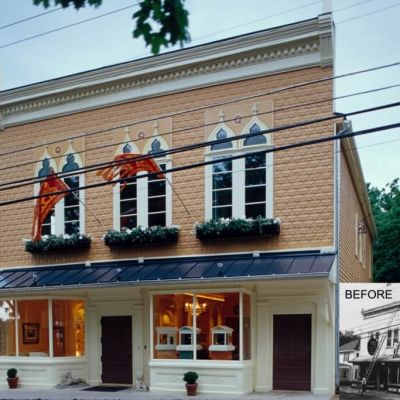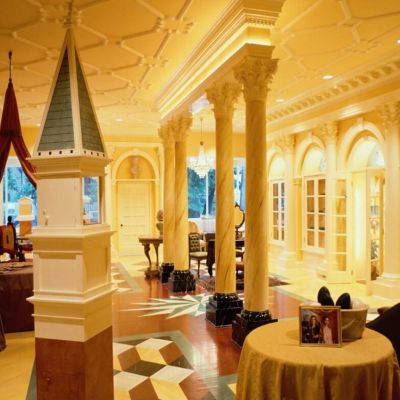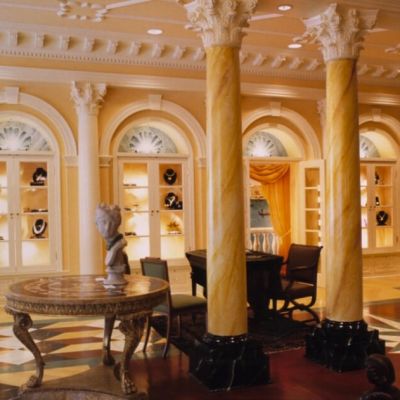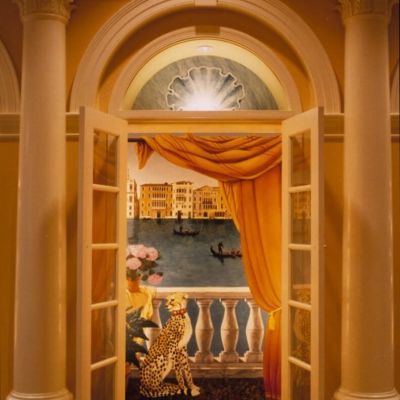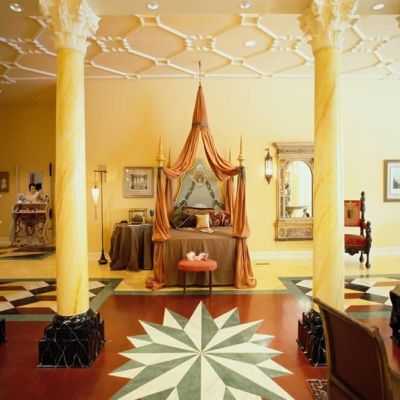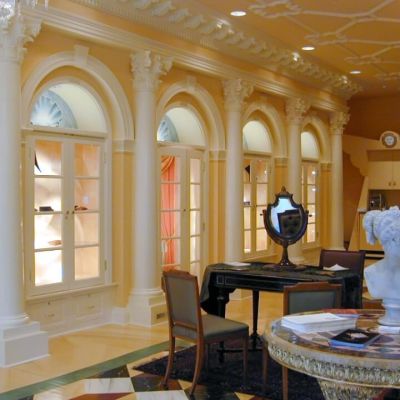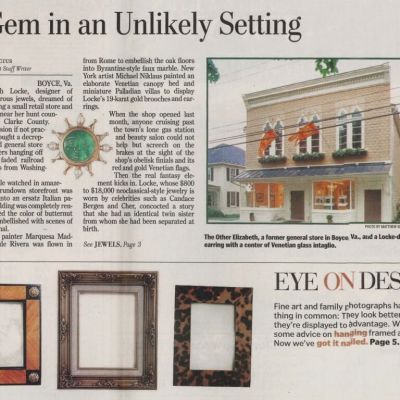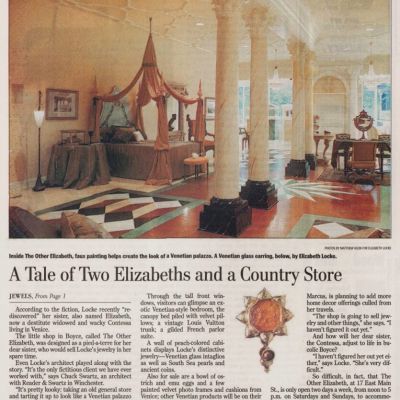THE OTHER ELIZABETH
ELIZABETH LOCKE JEWELS
17 EAST MAIN STREET
BOYCE, VIRGINIA
THE CONTESSA’S STORY
Not so very long ago twin girls were born. The unexpected joy of welcoming two babies left the parents at a loss for names so both girls were named Elizabeth. Middle names were less difficult and Louise and Victoria were chosen. Almost immediately their parent’s initial joy was shattered when, at only two days of age, Elizabeth Victoria was stolen by gypsies from her hospital crib. Despite massive search efforts, Elizabeth Victoria was never found.
Elizabeth Louise, prudent and obedient, was brought up carefully, her parents ever-fearful for her safety. She studied diligently, made her bed each morning, never raised her voice, and graduated with honors from a fine southern university.
Elizabeth Victoria was sold by the gypsies to a childless couple in Memphis. There the irrepressible and rebellious child did as she pleased and terrorized all around her. Her room was always knee-deep in toys, her grade school teachers were terrified by her accuracy with a slingshot, and the local sheriff grew weary of wresting the unruly child from the clutches of visiting carnivals. When, at age twelve, she finally and definitively ran away from home, her adoptive parents breathed a quiet sigh of relief.
Elizabeth Victoria had not gone very far at all; in fact, she had merely ridden her bike a few blocks away to Graceland where she immediately caught the eye of Elvis and moved in. There she received the remainder of her meager education: proper application of eyeliner and the ability to listen to men with rapt attention. When Elvis decided to marry another young, eye-lined resident of Graceland, Elizabeth Victoria’s heart was broken. She left Memphis and took a bus to New York where she stowed away on a freighter bound for Marseilles.
The next years are clouded with mystery as Elizabeth Victoria wandered across Europe. There are photos of her with Jagger in a murky London flat, stories of a long-term liaison with Belmondo, several small roles in lesser-known Fellini films, and whispers of a villa above Porto Ercole financed by Fiat. She merely smiles and says that, like Blanche Dubois, she was always dependent upon the kindness of strangers.
And then she finally fell in love.
Conte Federico Fragolin was the youngest of the notorious Fratelli Fragolin (Fulvio, Francesco, and Federico) last of the great Venetian playboys. The count saw Elizabeth Victoria feeding foie gras to some stray cats near Palazzo Fragolin and was instantly smitten. His friends and brothers were astonished to see the confirmed libertine begging the young American girl to marry him.
Despite the thirty-odd years of difference in their ages, Count Federico and Elizabeth Victoria were blissfully happy at Palazzo Fragolin. The Count constantly showered Contessa Elizabeth with gifts—the fabulous Fragolin tiara, a sable-lined gondola for damp winter evenings on the Grand Canal, and her favorite gift of all—-cheetah cubs named Precious and Tesoro.
It was a magical life of indolence and elegance and the Contessa enjoyed each golden moment.
Elizabeth Louise had also been busy—-graduated school, a series of interesting jobs, a sojourn in Italy in a Florentine garret, and an improbable but successful career as a jewelry designer. She fell in love, moved to a farm in Virginia and also fed stray cats. Occasionally, she thought about her long-lost twin.
Fate stepped in.
One day while Elizabeth Louise and her husband were enjoying a summer’s end vacation in Venice, Elizabeth Louise wandered into Café Florian for an afternoon aperitivo. As she sat sipping her Bellini, she heard the sounds of a woman sobbing. Looking up, she saw someone who could only be her twin sister, the Other Elizabeth!
They were both stunned by the recognition of their mirror image. Elizabeth Louise approached her distraught sister and gently led her to a secluded table. There she recounted the tragedy that had befallen their parents two days after the arrival of the twin Elizabeths. The Contessa, having consumed most of a jeroboam of Dom Perignon, did not seem to understand the great deal but continued to sob and wring her hands. Eventually, she told her tale.
Two weeks ago she had returned to Palazzo Fragolin after a hectic morning of shopping for shoes. Her faithful gondolier, Aldo, met her with terrible news—-Conte Fragolin had thrown himself off the Rialto Bridge! Unknown to the Contessa, her husband had completely squandered the considerable Fragolin fortune at the Casino during recent years. Not only was the Contessa widowed, she was destitute as well.
Elizabeth Victoria confessed to her twin that she had just spent her last million lire on the champagne she was drinking and was planning to throw herself from the Rialto Bridge to join her dearly departed husband. Aghast at the prospect, Elizabeth Louise promised to sort out her sister’s disastrous financial affairs. She also promised to take the Contessa back to Virginia where she would find a suitable residence as well as an occupation for her unconventional sister. The next day Elizabeth Louise went off to buy the last pieces of furniture remaining at Palazzo Fragolin and had them shipped to Boyce, Virginia, where she had recently purchased a building. She called her architect and told him of her plan to transfer her twin to Boyce and asked him to design surroundings in which the Contessa and her cheetahs would feel at home.
The move from Venice to Boyce has not been easy for the Contessa nor for her patient and generous sister. Sadly, the two now find that, apart from their genetic heritage and their joint love of jewelry, they have absolutely nothing in common. The Contessa does not seem to comprehend her new circumstances and continues to live an extravagant and disorderly life. Aldo, the faithful Fragolin gondolier who accompanied her to Boyce, has run away with a waitress from West Virginia so the Contessa now seeks companionship mainly at the Volunteer Fire Co. located a short walk from her new home. She can be found there most nights playing bingo until closing time when she takes the cheetahs for long rambles across the neighboring fields where they terrify the grazing cows. As a small gesture, Elizabeth Louise has asked the Contessa to open her palazzo each weekend to visitors who would like to see select jewelry designs by Elizabeth Locke. Given her sleeping habits, the Contessa receives at the Boyce palazzo from noon until 5 pm on Saturdays and Sundays.
The Contessa requests that if she is still asleep you tiptoe.
THE ARCHITECTS’ STORY
The architects were interviewed for what was described by the client as a small jewelry store project. They were quizzed on mental flexibility, flights of imagination, and their ability to work with difficult people on insane timelines, and insane people with difficult timelines. Once the architects were selected and their contract executed, the architects were told of the twin Elizabeths and their incredulous story.
In the sleepy railroad town of Boyce, an abandoned general store was selected for its spaciousness and obvious ties to the international jewelry market. The architects’ task was to transform this humble mercantile structure, built in the late 1800s, into an edifice worthy of Elizabeth Locke’s worldwide jewelry concerns, and The Contessa’s lavish lifestyle requirements, without irreparably harming the historic elements of the building.
The interior of the building is an eclectic blend of the two Elizabeths’ colorful personalities. It combines new, built-in custom casework and lighting, to best highlight Elizabeth Locke’s distinctively ornate and colorful jewelry, with The Contessa’s many treasures from her far-flung shopping and romantic conquests.
PROJECT INFORMATION
“The Contessa’s Story” Copyright 2000 Elizabeth Locke Jewels
Elizabeth Locke, Owner
PROJECT CREDITS
- Builder: Blue Ridge Builders, Boyce, Virginia
- Structural Engineer: Painter- Lewis, P.L.C., Winchester, Virginia
- Photographer: Matthew Klein, New York, New York
